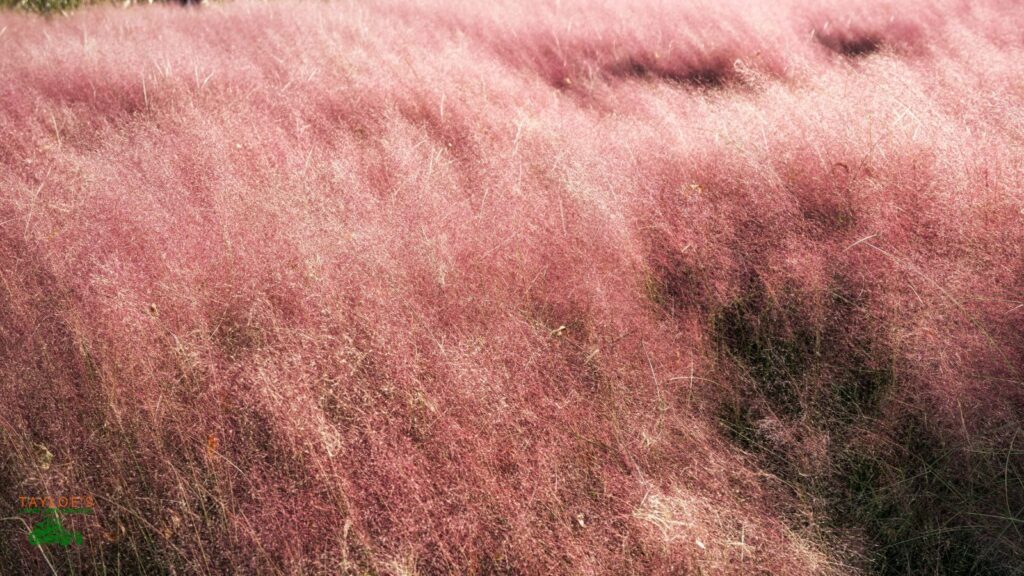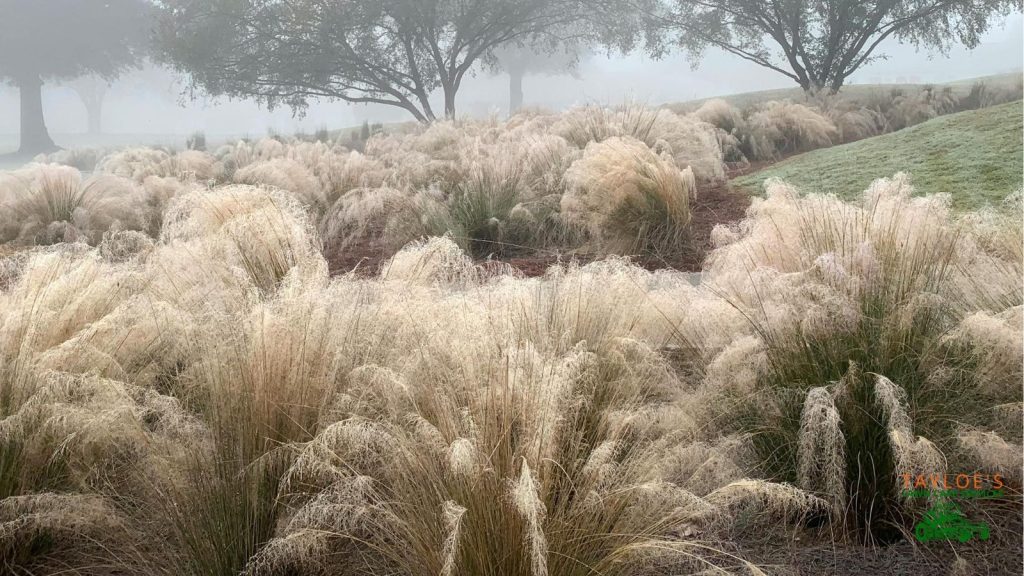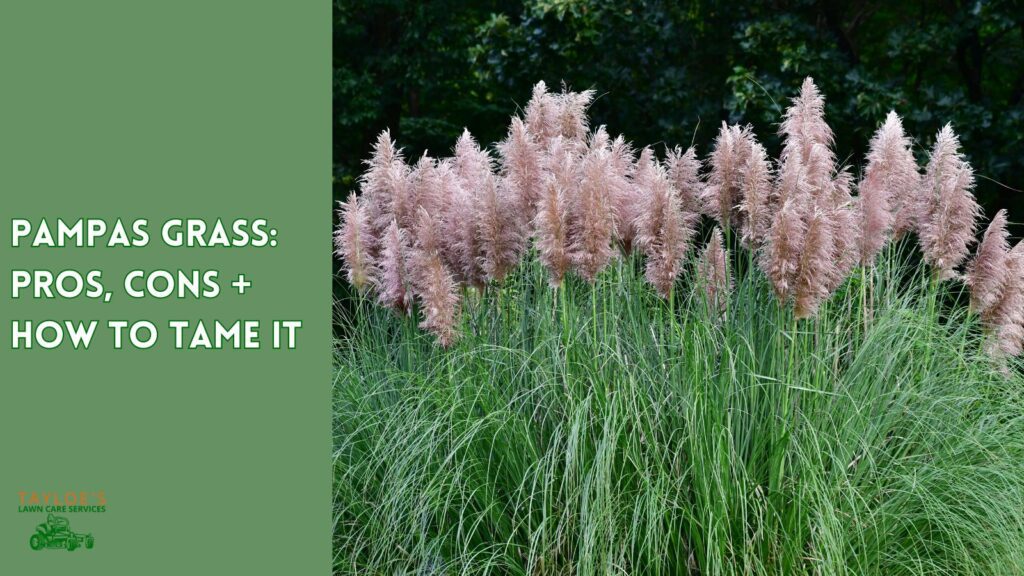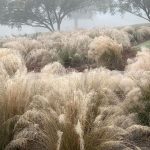Last Updated on: 11th December 2025, 05:11 pm

What is fountain grass?
Fountain grasses, also known as Pennisetum, is a type of ornamental grass that brings a touch of elegance to any garden. Native to Africa and Asia, this perennial grass is celebrated for its graceful, arching plumes and lush green foliage.
Its flowing texture adds a sense of movement and beauty to landscapes, making it a favorite among gardeners and landscapers alike.
One of the key reasons for its popularity is its low maintenance requirements. Fountain grass is drought-tolerant once established and can thrive in various settings, from sunny borders to rock gardens. Its versatility and ability to enhance the visual appeal of any space make it a must-have for any garden.
Use little maintenance ornamental grasses to enhance the landscape.
At Tayloe’s Lawn Care Services, LLC, a well-designed landscape is more than just a visual delight—it’s an experience. One way to create this experience is by incorporating fountain grasses into your garden or lawn. For optimal growth, the best place to plant fountain grass is in an area with full sunlight exposure and well-drained soil. These versatile grasses add vibrant colors and textures and bring a sense of movement and life to any space.
Today, we’ll introduce you to six fantastic fountain grasses that will transform your landscape. You’ll also learn the benefits of including the low-maintenance stunners in your yard and ideas on where you can use them.
6 Little Maintenance Plants with Great Ornamental Value
Here are some head-turning species you can use to create a focal point in your yard.
1) Pennisetum alopecuroides (Fountain Grass)
Fountain Grass, or Pennisetum alopecuroides, is popular for its graceful, arching plumes and lush green foliage. Pennisetum alopecuroides is perfect for adding height and texture to your garden.
USDA Hardiness Zone: 5-9
Sunlight Requirement: Full sun to partial shade
Water Requirements: Moderate; prefers well-drained soil
Soil pH Requirements: Slightly acidic to neutral (6.0-7.0)
Pennisetum alopecuroides can thrive and provide beauty in the landscape for many years without replanting.
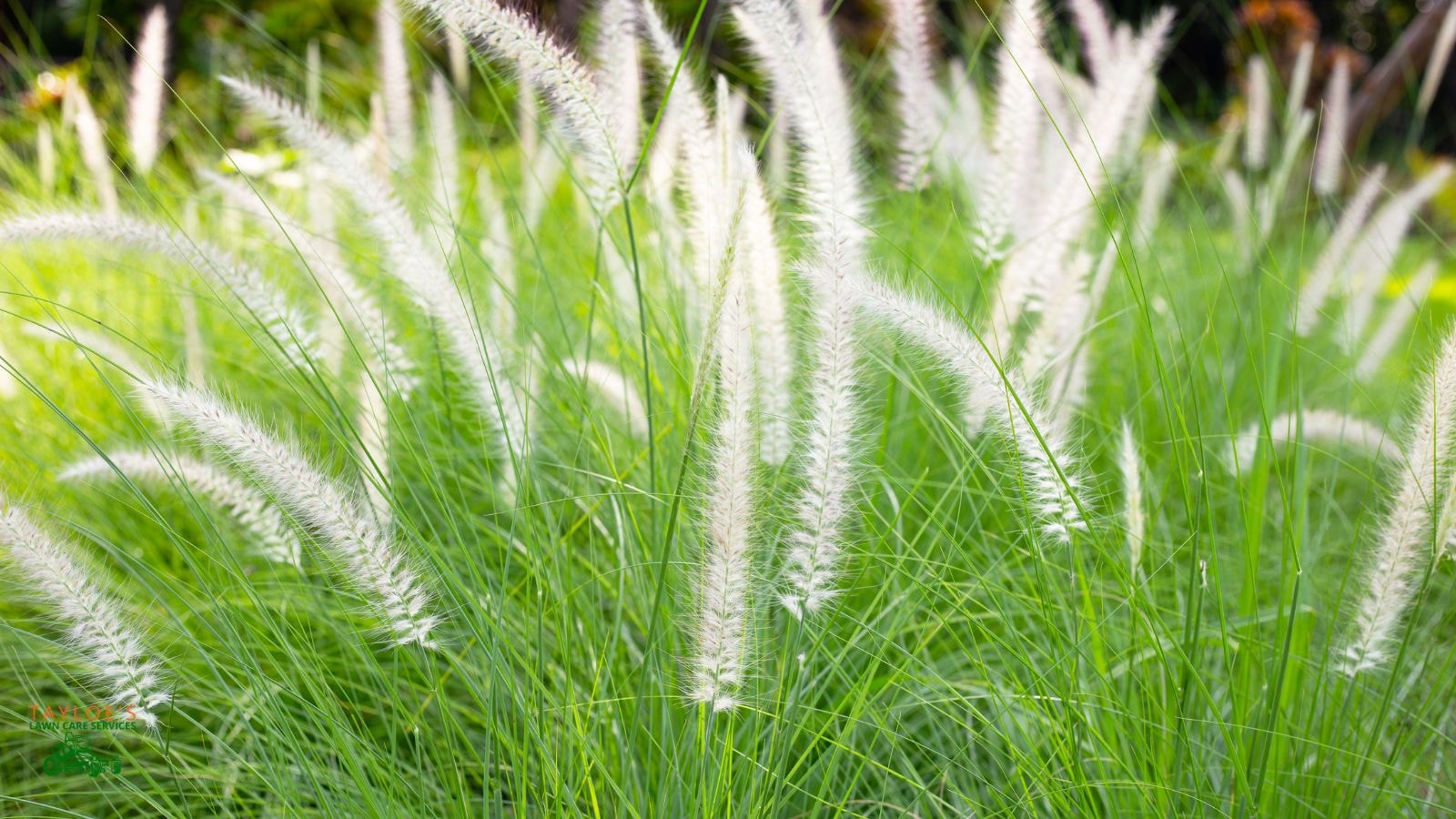
2) Muhlenbergia capillaris (Pink Muhly Grass)
Pink Muhly Grass is a showstopper with its airy, cotton-candy-like pink plumes. This grass creates a stunning visual effect, especially when planted in masses.
USDA Zone: 6-10
Sunlight Requirement: Full sunlight
Water Requirements: Low to moderate; drought-tolerant once established
Soil pH Requirements: Slightly acidic to neutral (5.5-7.0)
3) Liriope muscari ‘Variegata’ (Variegated Lilyturf)
Variegated Liriope, or Variegated Lilyturf, is a versatile grass with striking green and cream-striped leaves. It’s perfect for adding a pop of color to shady areas.
USDA Zone: 5-10
Sunlight Requirement: Partial to full shade
Water Requirements: Moderate; prefers moist, well-drained soil
Soil pH Requirements: Slightly acidic to neutral (5.5-7.0)
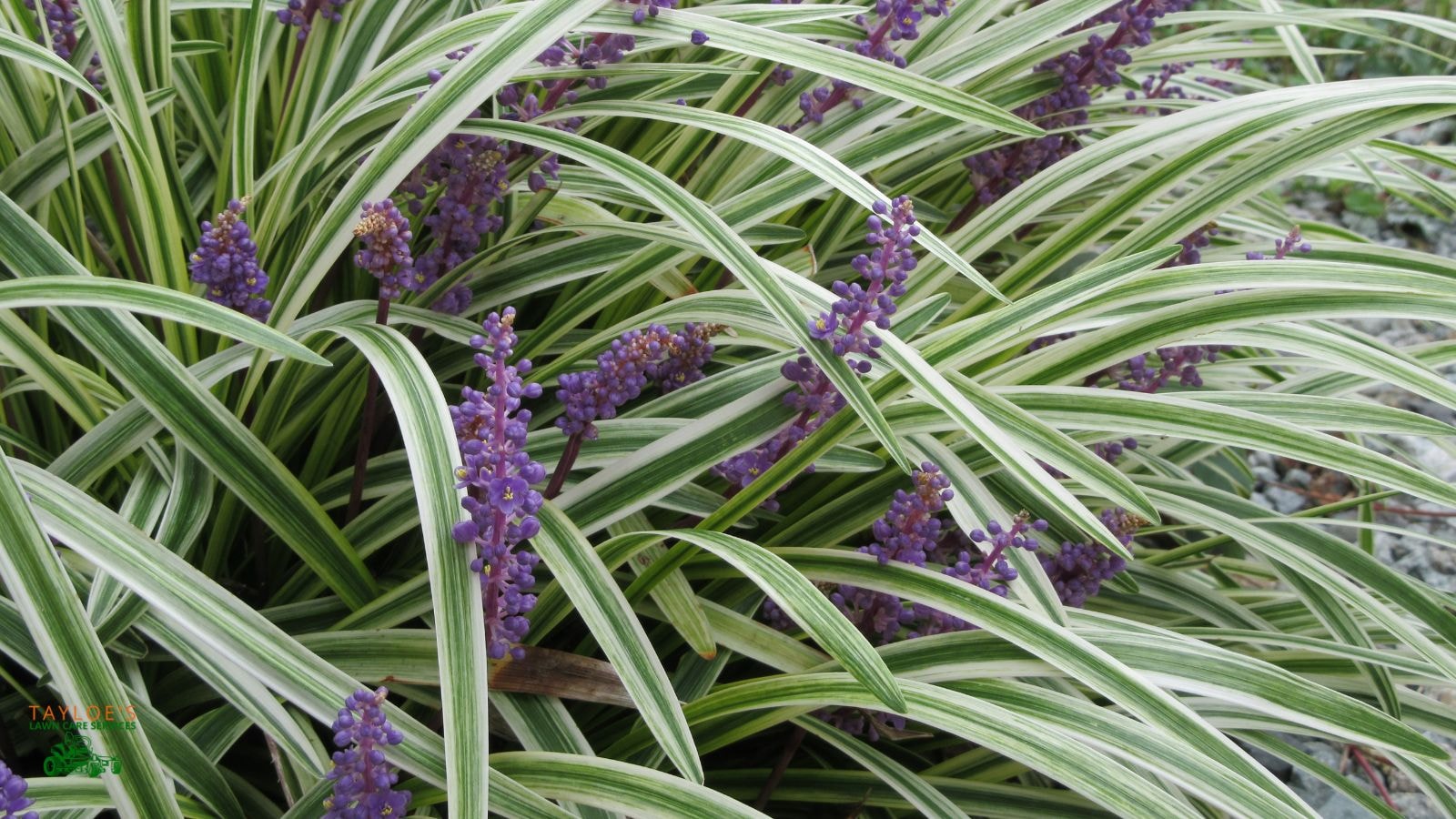
4) Miscanthus sinensis ‘Morning Light’ (Japanese Silver Grass)
Japanese Silver Grass, or Miscanthus sinensis ‘Morning Light’, is known for its fine, silvery-green foliage that glows in the sunlight. It’s an excellent choice for adding vertical interest to your garden.
USDA Zone: 4-9
Sunlight Requirement: Full sun
Water Requirements: Moderate; prefers well-drained soil
Soil pH Requirements: Slightly acidic to neutral (6.0-7.0)
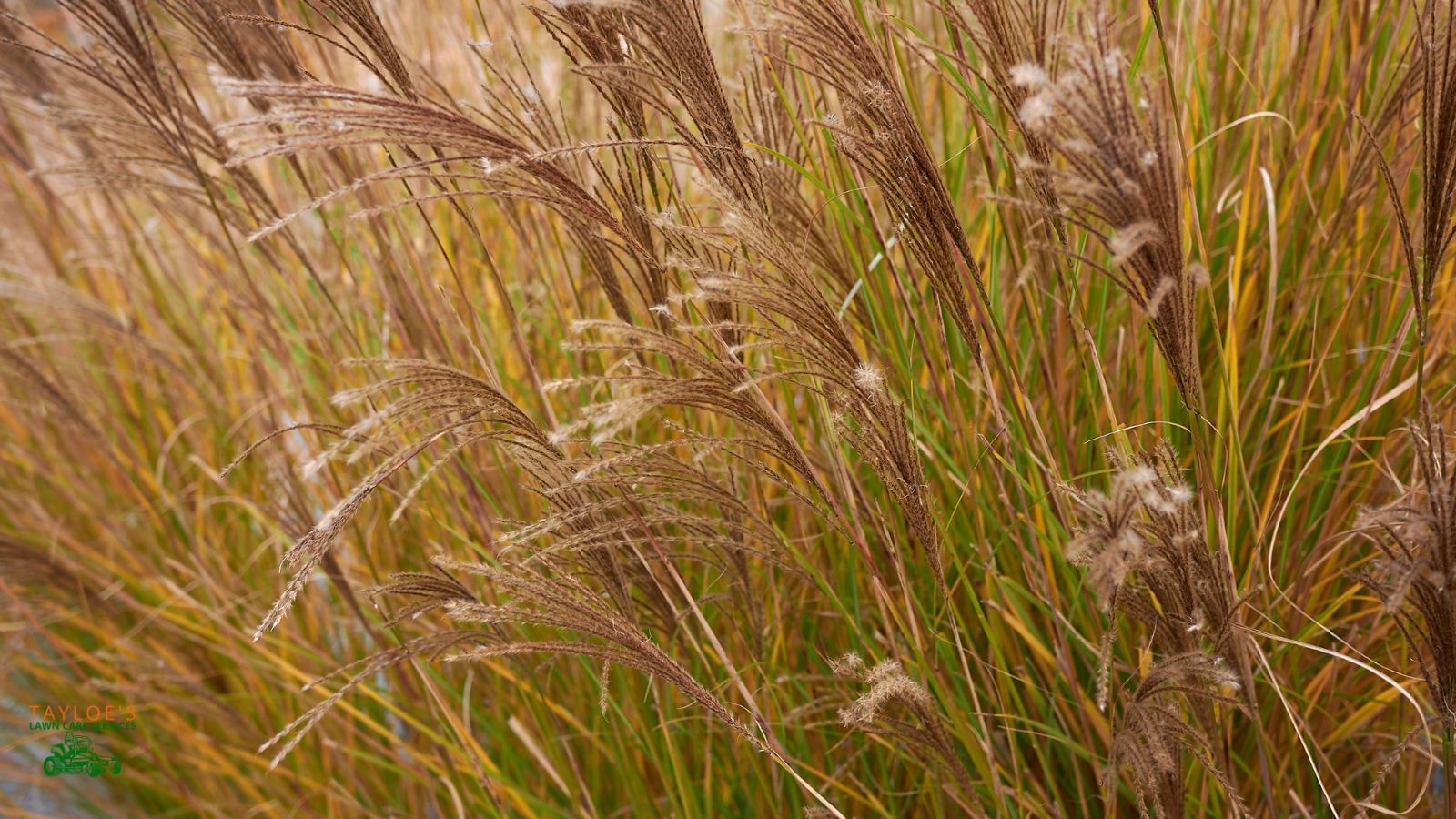
5) Pennisetum setaceum ‘Rubrum’ (Purple Fountain Grass)
Purple Fountain Grass, or Pennisetum setaceum ‘Rubrum’, is a stunning ornamental grass that features rich burgundy foliage and feathery plumes that sway gracefully in the wind. It’s a standout choice for adding contrast to green landscapes.
USDA Zone: 9-11 (grown as an annual in cooler climates)
Sunlight Requirement: Full sun
Water Requirements: Moderate; drought-tolerant once established
Soil pH Requirements: Slightly acidic to neutral (6.0-7.0)

6) Pennisetum purpureum (Elephant Grass)
Elephant Grass, or Pennisetum purpureum, is a large, dramatic ornamental grass that can grow up to 10 feet tall. It is often used for privacy screens, windbreaks, or as a bold accent in tropical-style gardens. While it’s primarily cultivated for forage in agricultural settings, its tall, dense growth and broad, green leaves make it an eye-catching decorative grass in residential landscapes.
USDA Zone: 8-11
Sunlight Requirement: Full sun
Water Requirements: High; prefers moist, fertile ground
Soil pH Requirements: Slightly acidic to neutral (5.5-7.0)
NOTE: We include this grass because clients ask about it. However, its cold hardiness zone requirements make it an annual in our area, except perhaps if we have an unusually warm winter.
Planting and Care
Planting and caring for fountain grass is a straightforward process that rewards you with stunning results. Here are some tips to ensure your fountain grass thrives:
Location: Choose a spot with full sun and well-drained soil. While fountain grass can adapt to various soil types, it prefers soil enriched with organic matter.
Timing: Plant your fountain grass in the spring or fall when the weather is cooler. This gives the grass time to establish itself before the heat of summer sets in.
Watering: During the first growing season, water your fountain grass regularly to help it establish a strong root system. Once established, it becomes drought-tolerant and requires minimal watering.
Fertilization: In the spring, apply a balanced fertilizer lightly to encourage healthy growth. Be cautious not to over-fertilize, as this can lead to weak growth and reduced flowering.
Pruning: In late winter or early spring, prune away any dead or damaged foliage. This helps maintain the plant’s shape and encourages fresh, vigorous growth for the new season.
By following these simple steps, you can enjoy the beauty and movement of fountain grass in your garden with little maintenance.
Benefits of Fountain Grasses
Adding fournain grasses to your landscape is a smart, low-maintenance choice that provides a range of benefits:
Year-Round Interest: Many ornamental grasses provide seasonal beauty, with colorful foliage in spring and summer, feathery plumes in fall, and striking seed heads that add winter interest when they turn brown.
They pair beautifully with other perennials. They create a backdrop or canvas behind other plants that love the sun.
Drought Tolerance: Once established, most fountain grasses require minimal watering, making them an excellent choice for water-wise landscapes.
Wildlife Attraction: Birds and pollinators love to find native grasses in the yard! Many species provide seeds for birds in winter and create shelter for beneficial insects.
Erosion Control: The fountain grasses’ deep, fibrous root systems help stabilize the ground, making them useful for slopes and erosion-prone areas.
Natural Privacy Screens: Tall-growing grasses like Miscanthus sinensis create a natural privacy barrier or windbreak, offering a softer alternative to fencing.
Minimal Maintenance: Unlike high-maintenance flower beds, fountain grasses rarely need pruning, are generally pest-resistant, and don’t require fertilization beyond their initial planting phase.
Enjoy a Long Growing Season from Early Spring to Winter in Rock Gardens
Fountain grasses have a long growing season that typically begins in early to early spring here in eastern NC. New growth emerges when ground temperatures start warming the root ball up to around 55°F to 60°F, producing fresh foliage. Once they start growing, the cycle runs through late spring and early summer, with plants reaching full height by mid-summer.
By early fall, fountain grasses produce their signature feathery plumes, which add texture and movement to the landscape. These blooms persist into fall, often transitioning in color from soft pinks and purples to golden tans and bronzes.
As temperatures drop in late fall and early winter, the foliage and plumes dry out, creating a striking winter display. While some varieties remain upright, less cold-hardy plants commonly flop over in late winter. In early spring, cutting back the dried foliage to about 4-6 inches helps encourage fresh regrowth for the new season.
Use Fountain Grasses to Add Color to the Landscape
Fountain grasses are versatile and fit seamlessly into various landscape designs. Here are some of the best places to use them:
Rock Gardens: Grasses like Pink Muhly Grass and Variegated Liriope look stunning against rocks and boulders, adding softness and movement to dry, xeriscaped landscapes.
Mixed Borders: Plant fountain grasses alongside perennials and shrubs for textural contrast. Their airy plumes and fine texture add height and beautifully complement flowering plants in mixed borders.
Privacy Screens & Windbreaks: Tall grasses like Japanese Silver Grass create natural privacy barriers that block wind and noise while maintaining a natural look.
Accent Plants in Containers: Purple Fountain Grass is perfect for large pots and containers, adding an elegant, cascading effect when paired with flowers or succulents.
Around Water Features: Fountain grasses like Miscanthus sinensis thrive near ponds or fountains, softening the edges and adding a naturalistic feel to water gardens.
Mass Plantings on Slopes and Erosion-Prone Areas: Grasses with deep root systems, like Fountain Grass and Muhly Grass, help prevent soil erosion on slopes and banks, keeping the landscape intact. Choose dwarf varieties for even less maintenance.
Companion Plants and Design Considerations
Fountain grass is a versatile addition to any garden, offering numerous design possibilities. Here are some tips for choosing companion plants and incorporating fountain grass into your landscape:
Companion Plants: Select plants that complement the texture and color of fountain grass. Flowering perennials, shrubs, and trees make excellent companions, adding layers of interest and color.
Focal Points: Use fountain grass as a specimen plant or focal point in garden beds. Its graceful texture and beautiful plumes make it a standout feature that draws the eye.
Rock Gardens and Containers: Fountain grass is well-suited for rock gardens and containers. Its compact growth habit and striking appearance add texture and interest to these smaller spaces.
Mass Plantings: For a dramatic display, consider mass planting fountain grass. This approach creates a stunning visual effect, with waves of texture and color that sway gracefully in the breeze.
By thoughtfully pairing fountain grass with other plants and considering its placement in your garden, you can create a landscape that is both beautiful and dynamic.
Need Fountain Grasses? Give us a Call!
If you want to add beautiful warm-season grass to your yard, give us a call! After growth begins, you’ll enjoy beautiful, textural foliage until late summer or early fall, then feed local birds during the cold seasons.
We source our perennials from a local Department of Agriculture-certified nursery that specializes in native species. You will receive high-quality plants!
Connect with us on Facebook messenger, or call/text 252.287.3376.
Author Profile

- Randy Tayloe is the COO of Tayloe's Lawn Care Service, LLC. He is a certified custom applicator, recognized by the North Carolina Department of Agriculture Pesticide Division. A native of Bertie County, NC, and graduate of Bertie High School, he wants to beautify his home county - one yard at a time.
Latest entries
 FaunaOctober 3, 2025Fall decorations that endanger wildlife (and how to avoid the risks)
FaunaOctober 3, 2025Fall decorations that endanger wildlife (and how to avoid the risks) GardeningApril 1, 2025Fountain grasses add colorful foliage and movement
GardeningApril 1, 2025Fountain grasses add colorful foliage and movement GardeningMarch 21, 2025White cloud muhly grass growing guide
GardeningMarch 21, 2025White cloud muhly grass growing guide Lawn CareFebruary 25, 2025Should I mow every week?
Lawn CareFebruary 25, 2025Should I mow every week?

